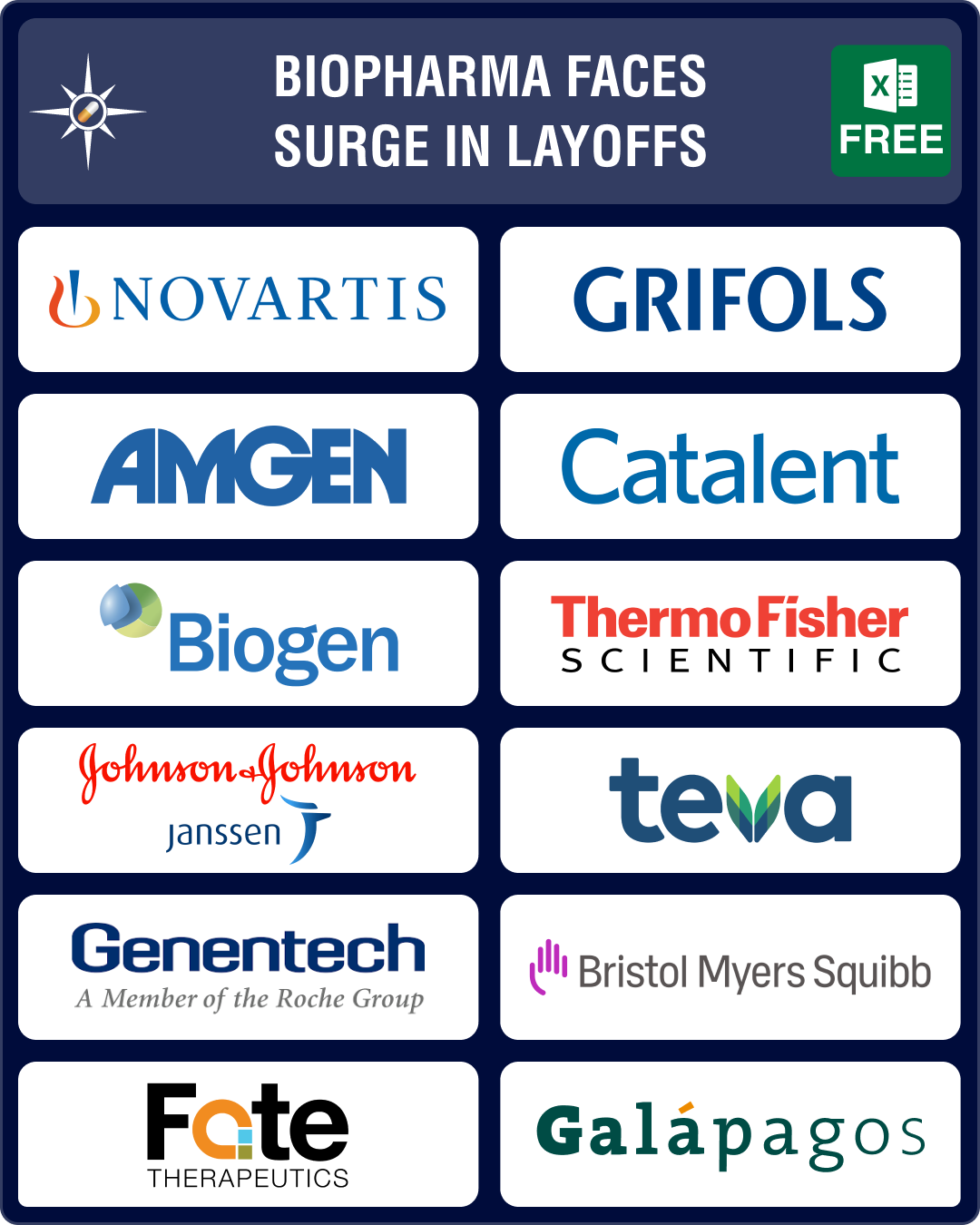
By PharmaCompass
2023-05-04
Impressions: 2453
Since 2022, layoffs have become commonplace. The ongoing global banking crisis, coupled with pre-existing factors such as the Ukraine-Russia conflict, inflation, looming recession and rising interest rates have made the business environment even more volatile and daunting. The kinks in the supply chain got exacerbated by China’s Covid policy. And all these economic challenges compelled companies to retrench employees the world over. While the surge in layoffs has been more apparent in the technology sector, the pharma sector has also been facing the headwinds.
Though the biopharma sector has experienced significant growth due to new technologies such as gene editing, cell therapy, messenger RNA and the Covid-19 vaccines and therapies, some drugmakers began to see revenues of their Covid products fall significantly with a drop in cases.
However, job cuts in the pharma industry aren’t limited to companies that make Covid products. Several others have announced job cuts citing restructuring, trial failures and holds, termination of deals, facility shutdowns and reprioritization of projects.
In the first quarter (Q1) of 2022, we saw around 30 pharma companies announce layoffs. In Q1 of 2023, the corresponding number went up to over 50. Overall, more than 100 biopharma companies had announced layoffs in 2022.
View Biopharma Layoff Tracker: 2022–Mid April '23 (Free Excel Available)
Pandemic-hit Grifols to cut 2,300 jobs; Catalent, Thermo Fisher lay off hundreds
Spanish pharma Grifols has announced the biggest layoff of 2023 so far — it plans to axe 8.5 percent of its global workforce, or around 2,300 employees, to save €400 million (US$ 427 million) annually. The Covid-19 pandemic dealt a severe blow to its plasma-derived medicines as blood collection collapsed around the world in 2020 and 2021. The drugmaker is now working on a “more efficient” platform to obtain plasma and reduce its expenses.
French vaccine maker Valneva said it will lay off 20 to 25 percent of its workforce in order to save US$ 12 million. Valneva cited clinical trial costs and expedited winding down of Covid vaccine-related activities as reasons behind the layoffs.
Some CDMOs have been hit equally badly. For instance, Catalent, which has played a critical role in producing Covid-19 vaccines and therapies, has cut around 600 jobs across multiple facilities in the US, and Thermo Fisher Scientific, a producer of Covid testing kits, has laid off around 500 employees across various locations in California between January 2022 and the middle of April 2023.
Meanwhile, US-based Axcella said it will lay off 85 percent of its staff as it ended work on
its NASH program to focus on developing a long Covid therapy. Last July,
another US company, Inovio, said it will cut 18 percent of its workforce due to its troubled Covid program. And this year, it plans
to downsize again and focus on its human
papillomavirus (HPV) program.
View Biopharma Layoff Tracker: 2022–Mid April '23 (Free Excel Available)
Novartis to cut up to 8,000 jobs, J&J to downsize as part of restructuring
Big pharma companies such as Novartis and Johnson & Johnson (J&J) have announced plans to restructure their businesses, and job cuts are a part of that exercise. In April 2022, Novartis announced plans to save at least US$ 1 billion by 2024 by combining its pharmaceuticals and oncology business units to form a new Innovative Medicine unit with the goal of achieving sales growth of at least 4 percent through 2026. It also revealed plans to spin off Sandoz to focus on patented prescription medicines. As a result of these changes, the Swiss drugmaker announced plans to eliminate up to 8,000 jobs.
Novartis is moving ahead with the job cuts and has announced plant closures in the US. In addition, Novartis slashed 400 jobs in India following a new sales and distribution agreement with Dr. Reddy’s Laboratories.
Similarly, as J&J moves ahead with plans to spin off its consumer health, it is cutting jobs. J&J is also restructuring the infectious disease and vaccine groups of its Janssen division and has planned global layoffs. Fate Therapeutics, a former partner of J&J, laid off 315 staff after ending its agreement with the company. Gilead has also cut jobs at the former Immunomedics headquarters in New Jersey and relocated the site to a larger space with no manufacturing.
View Biopharma Layoff Tracker: 2022–Mid April '23 (Free Excel Available)
Merck, BMS cut staff at acquired companies; Biogen downsizes due to Aduhelm, Tecfidera
Many retrenchments in the biopharma sector have been a result of acquisitions. Merck laid off around 143 employees from its Acceleron division in Cambridge, Massachusetts, shortly after acquiring the Boston-based company for US$ 11.5 billion in March 2022.
BMS has also laid off 261 employees across two San Diego sites following its acquisition of Turning Point Therapeutics for US$ 4.1 billion. Similarly, US biotech Flexion Therapeutics laid off 110 employees, after being acquired by Pacira BioSciences.
Six months after acquiring Kadmon Holdings, Sanofi is closing its Kadmon New York facility and laying off 25 employees. Sanofi-Aventis Korea is reducing its workforce through a voluntary retirement scheme. And AbbVie laid off 99 staffers from a single facility in Irvine (California), which was once an Allergan facility (a company it acquired in 2019 for US$ 63 billion).
In 2022, Amgen made some high-value acquisitions and agreements – it bought rare disease drugmaker, Horizon Therapeutics, for US$ 27.8 billion and ChemoCentryx for US$ 4 billion as part of its growth strategy. But this year, Amgen has announced layoffs on two occasions, retrenching a total of around 750 employees to realign its expenses in the face of intensifying pressure on drug prices and high inflation. And Roche’s Genentech unit has shut down operations at its production facility in South San Francisco, laying off 265.
In December 2021, Biogen had announced plans to lay off up to 1,000 staffers in an effort to cut about US$ 500-750 million in costs following the lower-than-expected sales of its controversial Alzheimer’s disease drug, Aduhelm, This year, Biogen has trimmed its multiple sclerosis team due to generic competition to its blockbuster drug Tecfidera. The job cuts were necessitated after the company failed to defend the market exclusivity of the drug through several lawsuits in the US.
Japanese drugmakers Daiichi Sankyo and Eisai have shut down their R&D units in the US. While Daiichi has closed its R&D unit in San Francisco that employed 60 people, Eisai has closed its oncology R&D wing in the US, H3 Biomedicine, a move that has resulted in the loss of 88 jobs.
View Biopharma Layoff Tracker: 2022–Mid April '23 (Free Excel Available)
Drug rejections, trial failures lead to job cuts at Akebia, Y-mabs, Spectrum
Several companies, such as Akebia, Y-mabs, Spectrum, have laid off sizable portions of their workforce due to drug rejections by the US Food and Drug Administration (FDA). Akebia laid off 42 percent of its workforce after FDA rejected its anemia drug vadadustat. Similarly, Spectrum laid off most of its R&D team after FDA rejected its drug poziotinib in November 2022. In January 2022, it had terminated 30 percent of its workforce. The same was the case with Y-mabs — a substantial number of employees lost their jobs after FDA rejected its drug omburtamab.
In April 2022, Bluebird bio reduced its workforce by 30 percent to cut costs. Its gamble paid off as the FDA approved two of its cell and gene therapies – Skysona and Zynteglo – a few months later.
Meanwhile, Galapagos dropped its kidney and fibrosis programs to focus on oncology and immunology candidates, laying off around 200 staffers. And disappointing data from a late-stage trial of its drug for symptomatic transthyretin amyloid cardiomyopathy (ATTR-CM) — avramidis — forced BridgeBio to announce retrenchment of an undisclosed number of employees last year.
View Biopharma Layoff Tracker: 2022–Mid April '23 (Free Excel Available)
Our view
The biopharma industry grew impressively in 2022. Our analysis of combined (global) revenues of 15 leading (randomly selected) drugmakers in 2021 and 2022 reveals an impressive growth in revenues of around 7 percent. However, in 2023, a third of these drugmakers expect a drop in revenues, with Pfizer expecting its turnover to drop by over 30 percent this year. The reduced guidance may result in more layoffs.
As we move into Q2, the layoff trend continues unabated. Last month, Thermo Fisher announced it will lay off 218 employees at three of its locations in San Diego, California, due to reduced demand for its Covid-19 products. These facilities will close in June. Japanese drugmaker Sumitomo and its subsidiary Sunovion Pharmaceuticals have announced plans to lay off 223 workers.
The current business environment is not likely to cheer the job market. We have to wait for the cycle to turn.The PharmaCompass Newsletter – Sign Up, Stay Ahead
Feedback, help us to improve. Click here
Image Credit : Layoff Tracker of Q1, 2023 by PharmaCompass license under CC BY 2.0
“ The article is based on the information available in public and which the author believes to be true. The author is not disseminating any information, which the author believes or knows, is confidential or in conflict with the privacy of any person. The views expressed or information supplied through this article is mere opinion and observation of the author. The author does not intend to defame, insult or, cause loss or damage to anyone, in any manner, through this article.”







